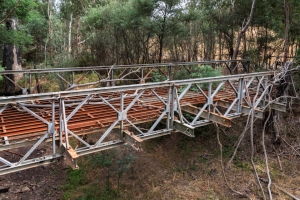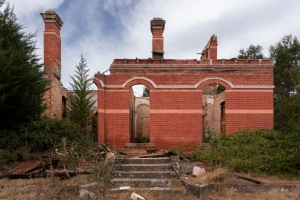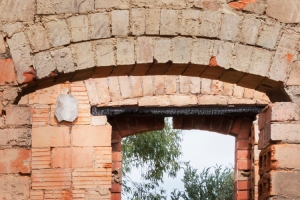
One of the many stories shared by my friend John over a glass or two of red was of his grandfather who managed three gold mines in a place called Clonbinane in central Victoria. For some reason this caught my imagination and immediately offered to take him there to find out what is still there.
Although it had been thirty years since his previous visit, John described the old timber bridge across Sunday Creek, the poppet heads to the mines, the post office and the old homestead. So, it was with different agendas, his to experience some family history and mine to hopefully take some interesting photographs, we set off on a journey of just over an hour.
Gold mining in the area lasted from 1870 to 1880 and was the main reason behind the township growing to 20 houses, a school and a post office. There are now as few as about five occupied houses.
John did not hold out too much hope that there would be much to see due to the Black Saturday fires that stormed through the area on 7 February 2009 heading for Mount Disappointment and beyond, however we were not too disappointed.
Stopping first at the original township, the original timber bridge had gone, replaced by a steel crossing built by the army, now derelict, and another existing concrete bridge. It was clear that access to the mine sites was through some private properties, so no further progress was made. The post office and the school were also destroyed in the fire. Continuing up the road, we stopped off, but did not linger, at the picnic grounds – a seemingly very popular long weekend spot for campers and trail bikes.


It was only on the way back that we spotted the ruins of the original homestead through the roadside trees so, ignoring the ‘Private Property’ sign, we just had to take a closer look.
Built in around 1885 and located a few kilometres south of the original Clonbinane township, heritage listed Clonbinane Park Homestead now lies in ruins, having been destroyed in the Victorian Black Saturday fires on 7 February 2009. For me this was an ideal subject to add to my growing portfolio of images that illustrate how the abandoned built environment is slowly overcome by unstoppable forces of nature.
Most of the external walls remain standing, some of them in a rather precarious state, with the chimney stacks and, more so, the north facing wall of the residence’s lookout tower dominating the remains. Although I managed to enter the inside of the house, it was impossible to access the front due to the proliferation of blackberry bushes. As we were leaving on the main road, we passed the main entrance drive, but unfortunately is was blocked by fallen trees, preventing us from going any further.
On leaving we stopped and chatted to one of the locals who gave John some further background, including the name of the overall landowner who would be able give consent to access the mine area. So, he is now resolved to undertake some further investigation and follow up with a further visit.
 As a bit of a footnote, one of the reasons I enjoy taking photographs of derelict buildings is that, as they decay, their hidden secrets are revealed. For example, the manner in which the door lintels are formed – a light timber beam with a very shallow double brick arch! Look carefully and there are other little gems!
As a bit of a footnote, one of the reasons I enjoy taking photographs of derelict buildings is that, as they decay, their hidden secrets are revealed. For example, the manner in which the door lintels are formed – a light timber beam with a very shallow double brick arch! Look carefully and there are other little gems!
To view the complete gallery of images: Clonbinane

7 Responses
A great set of pictures brings back a lot of memories as I had played at the old homestead when I was around seven years old. My dad would work weekends for old Captain Jewett, not sure of the spelling.
This would have been about 1960-61. I remember climbing the old tower although told not to as the stairs weren’t very safe even back then. We would stay the Saturday night and dad would work the Sunday before we headed home to Broadford. Great times as a kid, thanks for the pictures.
Hi Ken, many thanks for your personal note about what I am sure was an amazing residence in its day.
I was a friend of the owner Edmond Jowett he also lost his 1937 Packard in the fire .some car what a loss I remember it well I once cut and polished it at our Kew Service Station .
Hi Lionel, thanks for the additional information and pleased the post brought back memories
The ruins of Clonbinane Park homestead has been demolished for public safety reasons. The 500 Ha property remains in the Jowett family.
If you want more history of the area then follow Facebook Friends of Disappointment Secret Forest. It is a site for history and preservation of forest values.
Thank you for the update. I had hoped to get back there to take a few aerial shots with my drone, but clearly I have missed the boat. When I took those photos, I was with an elderly friend whose grandfather was the manager of the mine so I learned a bot about the interesting history of the area.
Dear Lionel, My name is John Ball – the “John” mentioned by my mate Martin Leitch who took the photographs. My grandfather, Edward “Ted” Ball was manager of the mines at Clonbinane at the turn of the century, and the men of the family would always raise the cry: “Here’s to Clonbinane!” when they met at the home of my father (Horrie Ball) in Bendigo in the 1950s. Grandfather was married to Edith May McDonald and they lived in a fine timber home on a bend in the Sunday Creek below three mines – the Golden Dyke, the Hercules are the two names I remember. They had seven children – Lionel, Roy, Edward (Ted), Horace (Horrie, my Dad), Olive, Honor and Bonnie. Grandfather once bought a horse, Lazy Bill, from Kate Kelly, sister of Ned, and raced it at the pony races at Moonee Valley before it became the well known racecourse. It hung for years over the doorway of my aunt Honor’s house in Erroll Street, North Melbourne. I live in Riddells Creek and my phone number is 0497766719. Please get in touch. Sincerely John Ball